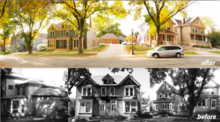4th Street Preservation Project
HSP played an instrumental role in initiating and planning the Fourth Street Preservation Project in Dayton’s Bluff, whe
493 Edmund
573 Charles
The home at 573 Charles was destined for the landfill after Habitat for Humanity purchased the workers cottage that was positioned next t
452 Thomas
452 Thomas was the flagship renovation project of Preserve Frogtown - a project that we took on in partnership with Frogtown Neighborhood
Tour: East Side to Lowertown
As the Mississippi River travels past downtown Saint Paul, it makes a sharp curve beneath towering sandstone and limestone bluffs. This stretch of river has been a focal point of human activity since the earliest phases of our history – and it continues to be a vibrant area that combines rich ecological resources with unique sites that remind us of our area’s diverse cultural heritage.
Tour: Payne Avenue
Saint Paul is known for its “Main Street” commercial districts that grew to serve the immigrants who settled the city’s neighborhoods a century ago. One of the liveliest of these districts is the East Side’s Payne Avenue, known in the 1930s as the “downtown of northeastern Ramsey County.”
“Global Beat on Main Street” identifies Payne Avenue today – a street that provides central meeting places, remains mindful of its heritage and is anxious to incorporate new cultures that enrich this strong, growing part of Saint Paul.
Tour: West Side
The contours of the earth define and set apart Saint Paul’s West Side. On the north, the great swoop of the Mississippi forms the point and two sides of a rounded triangle; a line of limestone cliffs – the shore long ago of the glacial River Warren – forms the base. The low plains inside the triangle, the flats, has invited immigrants, industry, and floods for more than a century and a half. The immigrants and those who followed them eventually expanded the West Side south to the city limit at Annapolis Street.
Tour: Selby Avenue
Since 1840, Saint Paul has taken on different identities: frontier hamlet, steamboat burg, provincial capital, railroad boomtown, city in stagnation, city in decline, city in revival. These transformations have left their marks all over town. Nowhere can one see them better than on Selby Avenue.
Download the tour below to follow the growth of Saint Paul from the empire building days of the 19th-century to a city of inviting neighborhoods.
Tour: Rice Street
Located in the North End neighborhood, Rice Street began as a commercial corridor that served Saint Paul’s working class. Rice Street is unassuming; when it was rushed into being more than a century ago, there was no time for ornamentation or ostentation. Despite its utilitarian appearance, Rice Street has a character that is unique to the street and the North End.
Download the tour below and take a trip that reveals a rich neighborhood history with proud ethnic and working class roots. Rice Street was and is a street that works.


